SIHH 2016 – Hands-on with the Jaeger-LeCoultre Master Ultra Thin Perpetual, in steel with black dial (live photos, specs & price)
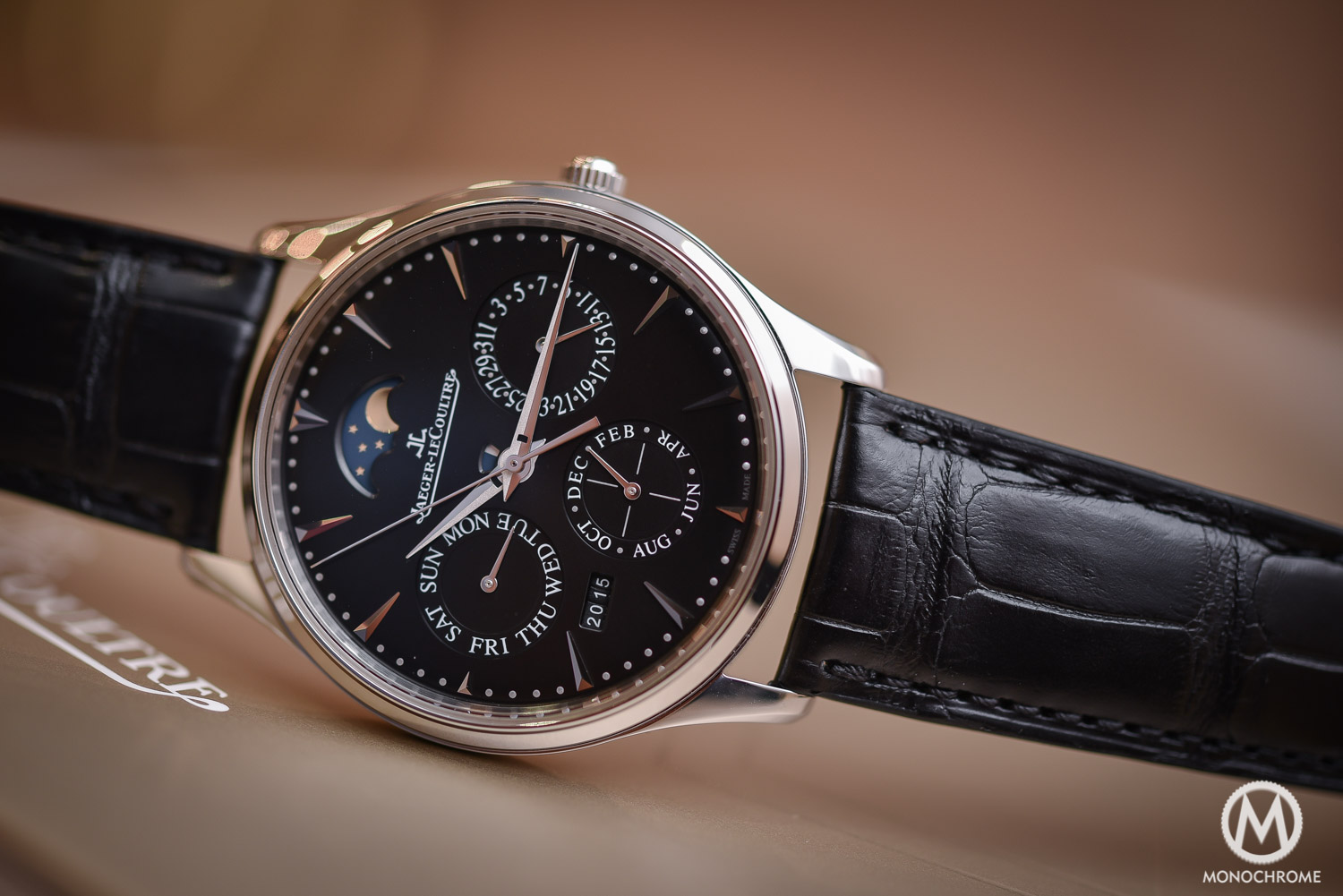
A long time ago I saw this extremely beautiful watch with its black face and several small sub dials with, for me at the time, unknown indications. It was the first time I saw a perpetual calendar and it was the Jaeger-LeCoultre Master Perpetual, belonging to the older Master Control series. This watch is etched into my memory and has been one of my all-time favorites ever since. All the better now Jaeger-LeCoultre is introducing a black dial version for their perpetual calendar again, now dubbed Jaeger-LeCoultre Master Ultra-Thin Perpetual.
Since the introduction of the first Master Ultra-Thin Perpetual, in 2013, we’ve seen several dial variations: silver/white-grained (only available in the white gold version), silver (available in a stainless steel boutique edition), and eggshell beige (in the 18k red gold version.) Now, three years later, the brand from Le Sentier introduces the black dial version, and it looks great. The black adds a bit of sportiness to the classic perpetual calendar complication.
Comparing the old and the new Perpetual Calendar
The perpetual calendar in the old Master Control collection was introduced in 1997 and phased out around 2004. It measured 37.2 mm in diameter and 10.1 mm in height, and inside ticked calibre 889/440/2. This ‘perpetual engine’ was based on JLC’s legendary calibre 889/2, which was paired with a perpetual calendar module (developed by IWC), and combined that was called cal. 889/440/2.
The new Master Ultra-Thin Perpetual Calendar, as introduced in 2013, measures 39 mm in diameter and 9.2 mm in height. Inside ticks the new calibre 868. I’ve always been a huge fan of the old QP (Quantième Perpétuel, or perpetual calendar in French), however now I have to admit that the new version wins, hands-down. The slightly larger diameter, the slimmer profile, the new movement, all changes for the better.
Also in terms of design, we see some changes when comparing old and new. The new Ultra-Thin Perpetual features polished rhodium-plated hour markers and small dots for minute markers; the older Master Perpetual featured simple short stick markers, painted on the dial. Another difference is that the perpetual calendar module has been turned 180 degrees, with the moon phase now at 12 o’clock and the month sub dial moved from 12 o’clock on the old, to the 6 o’clock position on the new. The year indication that used to be inside the month sub dial (when it was located at 12 o’clock), has now been moved to the side of the month sub dial, between 7 and 8 o’clock. Altogether the new dial looks much more balanced.
The dial of the Jaeger-LeCoultre Master Ultra Thin Perpetual watch displays the perpetual calendar indications in a balanced and extremely clear manner: day, month, date, year and moon phase. All the information is regulated by only one corrector. Once set, the automatic watch will not need any adjustment until 2100. The perpetual calendar mechanism takes into account the length of each month and counts 29th February every leap year.
Jaeger-LeCoultre Master Ultra Thin Perpetual on the wrist
The new Master Ultra Thin Perpetual sits beautifully balanced on the wrist. It’s lovely slim profile certainly helps, and so do the downward sloping lugs. While the silver dial edition might have a bit more “chic” to it, the black dial version is certainly a tad sportier, while remaining the classiness that goes hand-in-hand with its perpetual calendar complication. The stainless steel case is very nicely designed, and features elegant lines and shapes. The raised bezel is quite narrow, and because of that the dial is a bit bigger, and thus has more space for all indications.
The lugs are beautifully shaped, and feature a little ‘drop’ on the underside. The combination of the elegant shaped case, the large opening for the dial, and the narrow bezel, all add up to make this Master Ultra Thin to be a very well succeeded future classic. With a retail price of just under € 20k Euros (or € 16.300 Euros without tax/VAT) it is priced rather friendly! For comparison, the stainless steel version of the old Master Control had a retail price of € 15k shortly before it was discontinued in 2004. Not bad, not bad at all.
Perpetual calendar indications
Starting at the 12 o’clock position, we see the moon phase indication. This is what we call a simple moon phase indication and it makes one full rotation in 29.5 days. It has to be said that most moon phase indications in wrist watches are so-called simple moon phase indications, and these have a deviation of more than 44 minutes per month. To explain this, you should know that the moon rotates around the earth in 29 days, 12 hours, 44 minutes, and 2.9 seconds. The moon phase is visible through and semi-circular aperture.
Moving on to the next indication, the date, as positioned at 3 o’clock. This is a classic date indication with a hand pointing to the actual date, in a round slightly recessed sub dial. Printed in a circle are the odd dates and alternate dots for the even dates.
Next is the month indication, again in a slightly recessed sub dial, and a stainless steel hand point to the actual month. Even months are abbreviated, while the odd months are represented by a small dot. In the centre of the recessed sub dial is a crosshair. Just to the left side of the month indication is a four-digit year indication. While many perpetual calendars are equipped with a leap year indication, these QP’s are not equipped with year indication. This Jaeger-LeCoultre Master Ultra Thin Perpetual does feature a year indication and it is actually easier than a leap year, for the user.
Above the year indication, at the 9 o’clock position, is the day of the week indication. Again in a slightly recessed sub dial, and with a hand pointing to the day of the week which are all abbreviated.
When you think that this were all indications, than look again. Just above the centre of the dial, above the centre axis with hour, minute and second hand, is a small aperture in which you can see a blue/white disk. Both the hour and minute hand – dauphine style hands – have a small opening that allows the owner to see this indication, even when the hands are above the aperture. So yes, this is an important indication. It reminds the owner that you cannot adjust the calendar functions when the hour and minute hand indicate a time between 10:00 o’clock and 2:00 o’clock. The disk with white and blue makes a full rotation in 12 hours, and turns blue when the time is between 10 and 2. Just a small, but very important, reminder of when you can, and when you can’t adjust the calendar functions.
Jaeger-LeCoultre calibre 868
The Jaeger-LeCoultre calibre 868 is an automatic winding movement with a perpetual calendar, and was introduced in 2013. It is closely related to the annual calendar movement, JLC calibre 866. As we already said, it replaced the cal. 889/440/2, that was used in previous perpetual calendars of the brand.
Calibre 868 comprises 336 individual parts, and features a very nice finishing. The bridges are adorned with Côte de Genève, the main plate with pèrlage (circular graining) and all edges are beveled and polished. The rose gold rotor features the brand’s logo (JL) that now-a-days also features in the brand’s Gyrolab balance!
Some specifications:
- Case: polished stainless steel, 39mm x 9.2 mm, sapphire crystal with anti-reflective coating, case-back with sapphire crystal pane to see the movement
- Movement: 28,800 vph (4Hz), 46 jewels, power reserve of 38 hours, 1 main spring barrel,
- Indications: traditional full perpetual calendar with central hour, minute, and second, and subdials for date, month, day, and moon phase arranged at 3:00, 6:00, 9:00, and 12:00, respectively. A four-digit year window is placed at 7:30 while an adjustment warning indicator is just above the central hand axis.
The Jaeger-LeCoultre Master Ultra Thin Perpetual has a retail price of € 19.800 Euro including all taxes (or € 16.300 Euros before tax.) More info about the various Master Ultra Thin Perpetual models and their availability on the Jaeger-LeCoultre website.

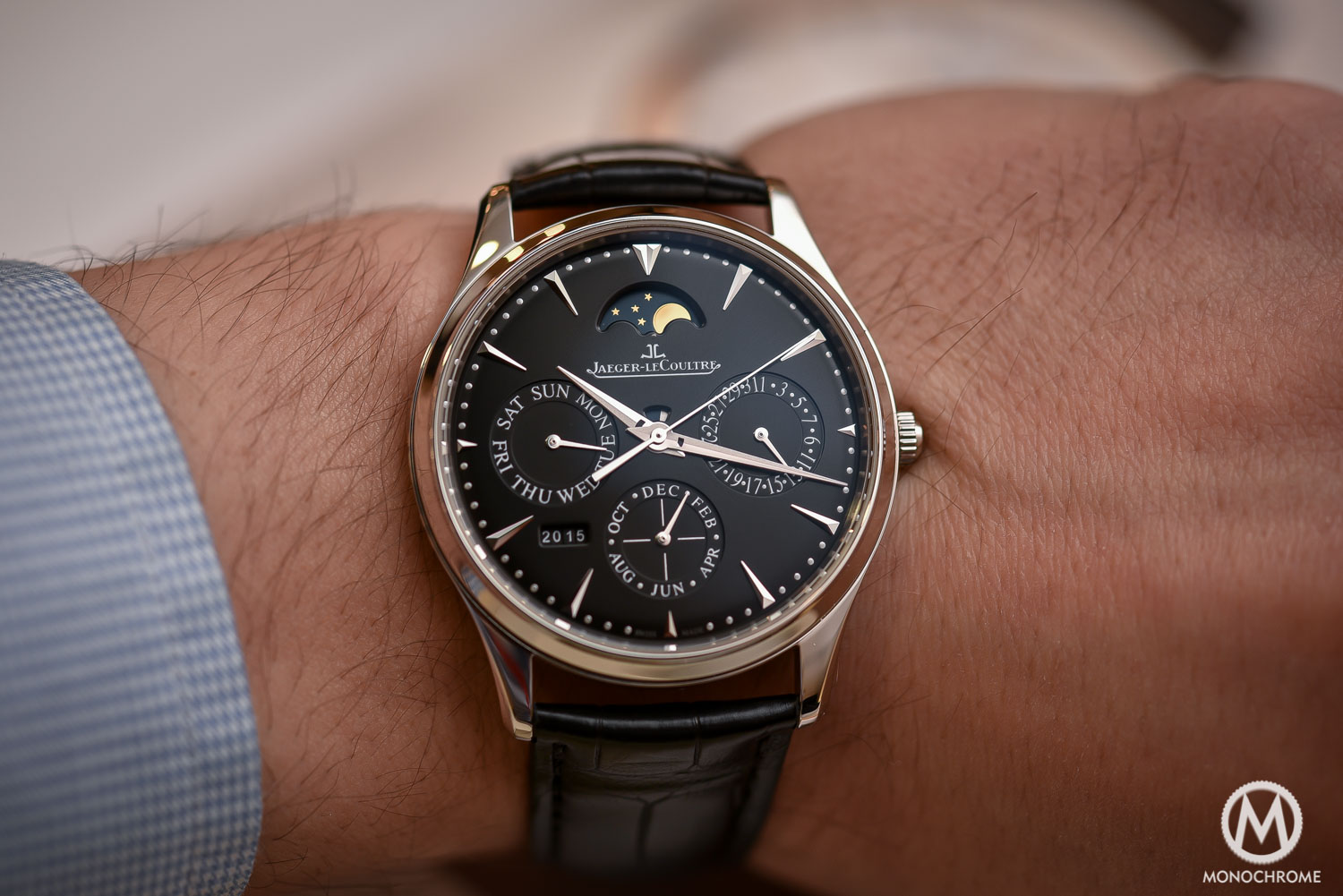
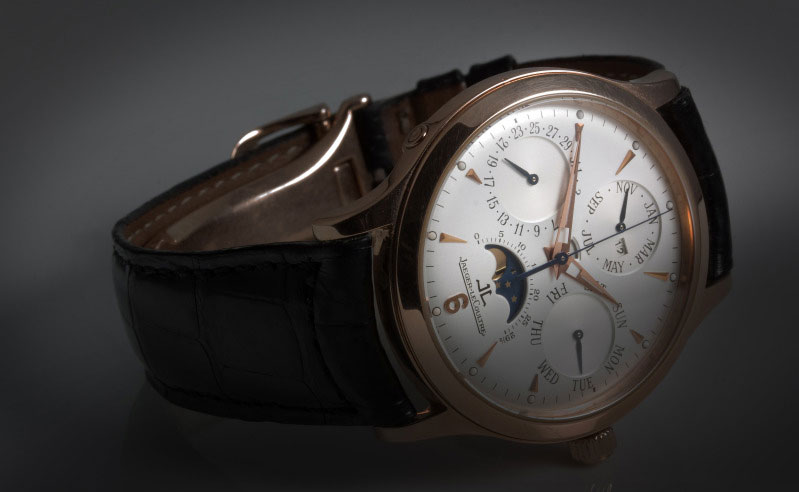
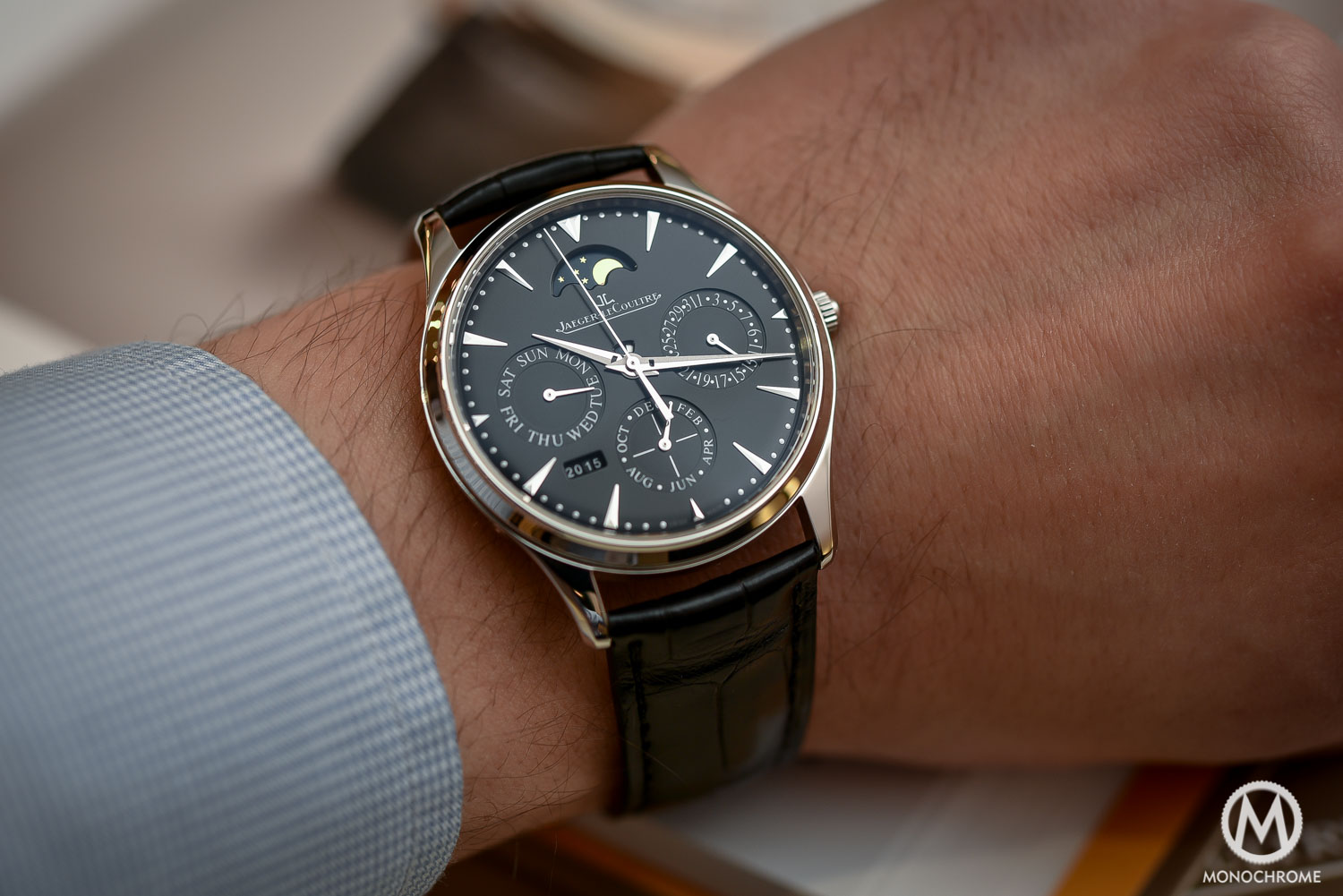
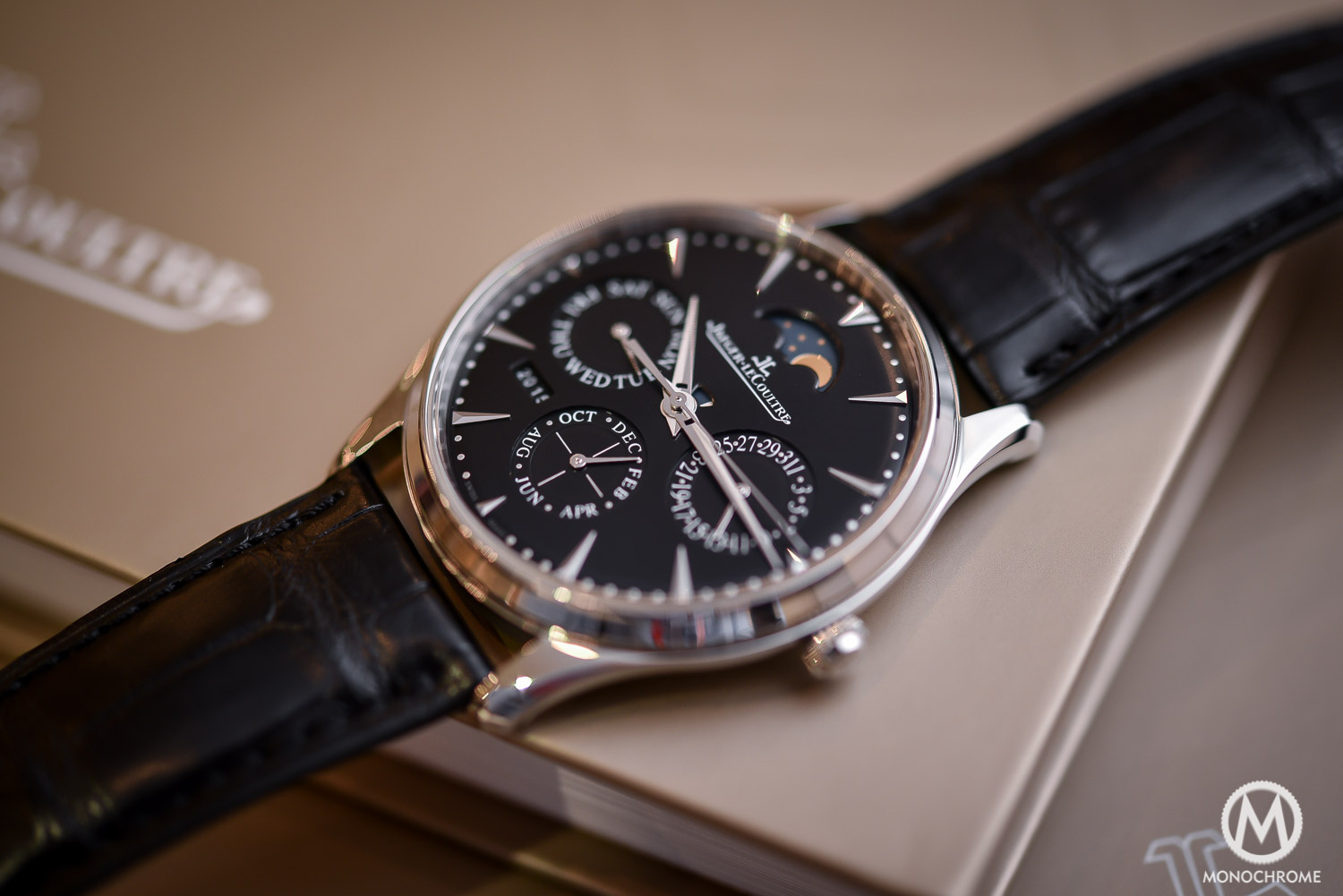
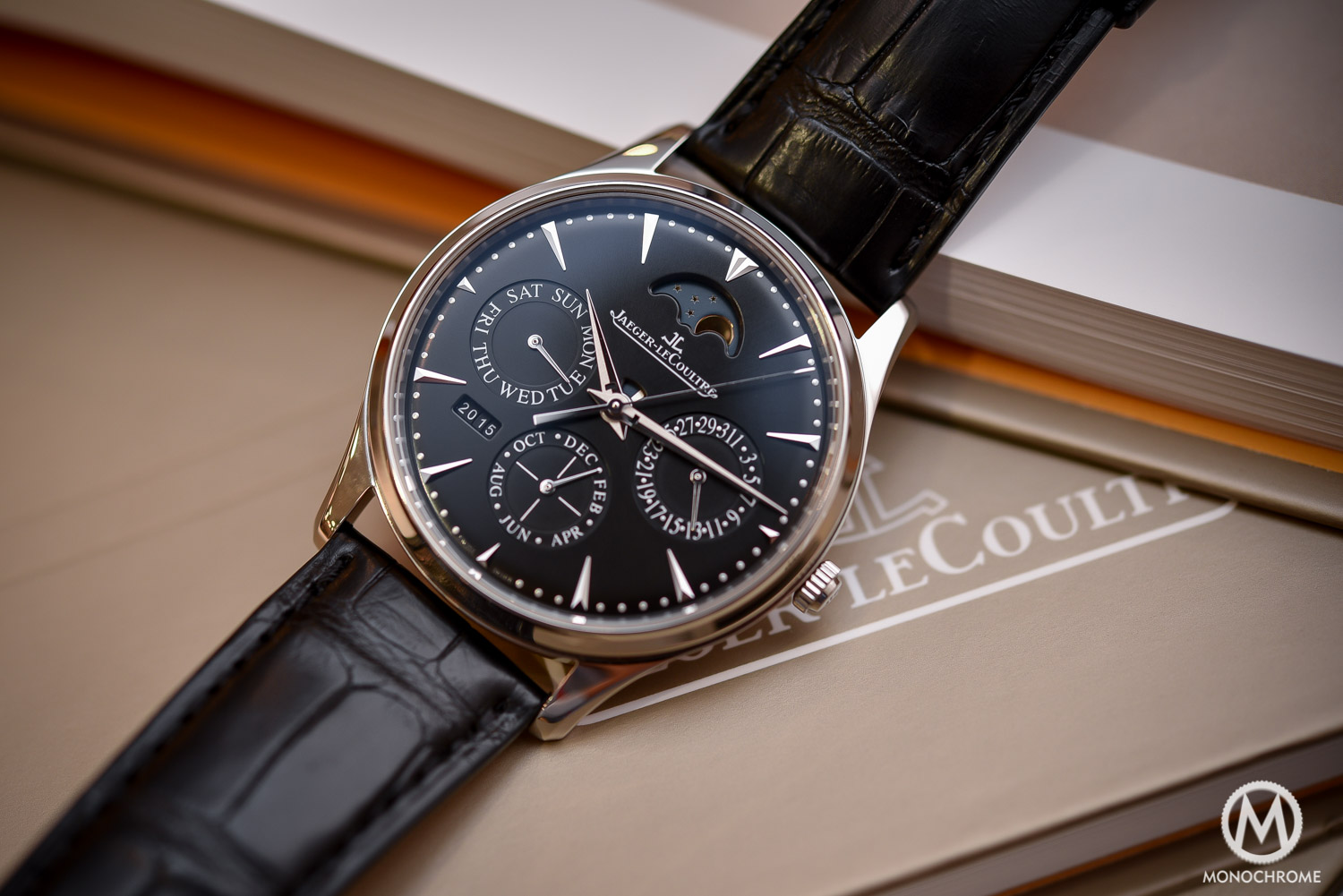

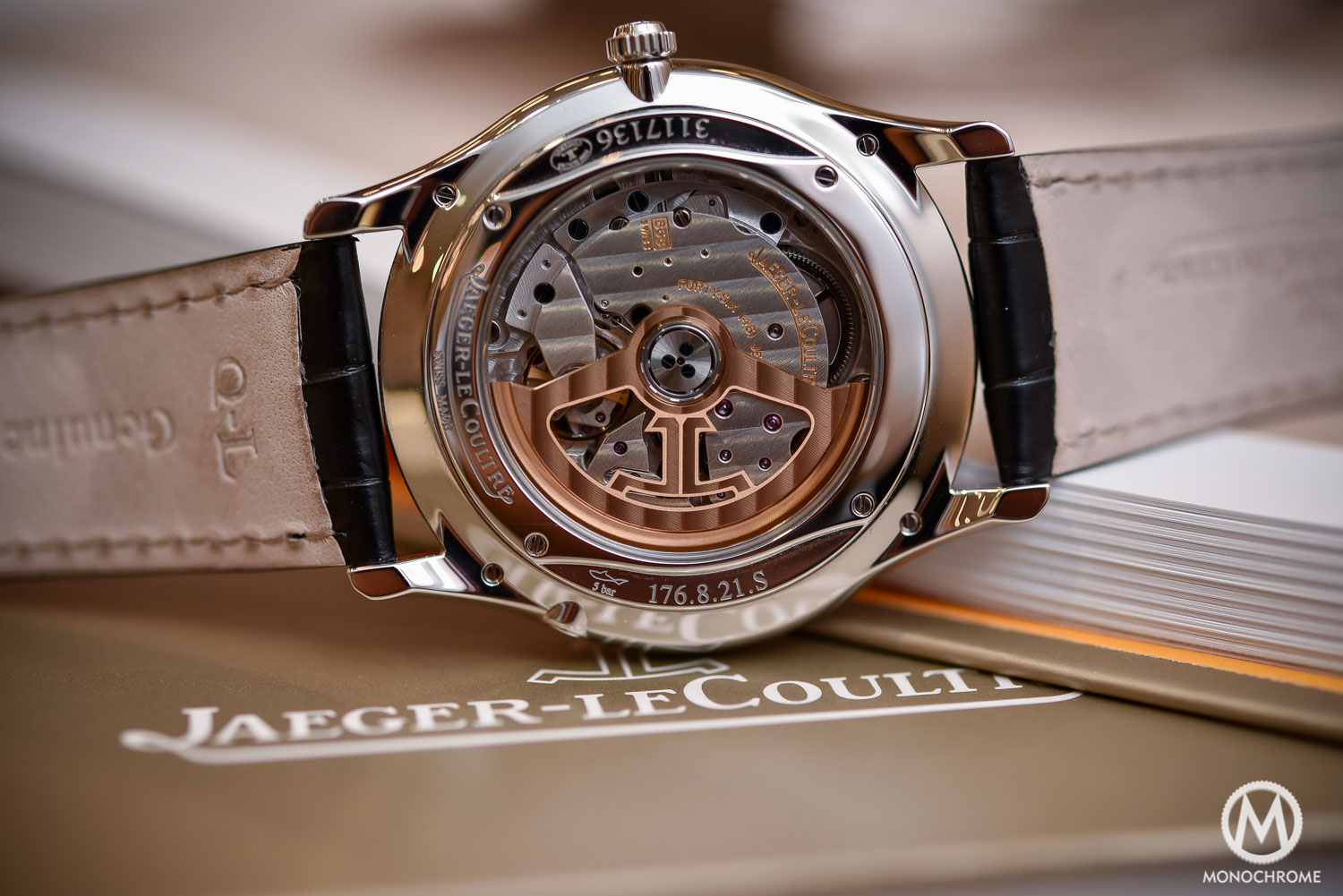

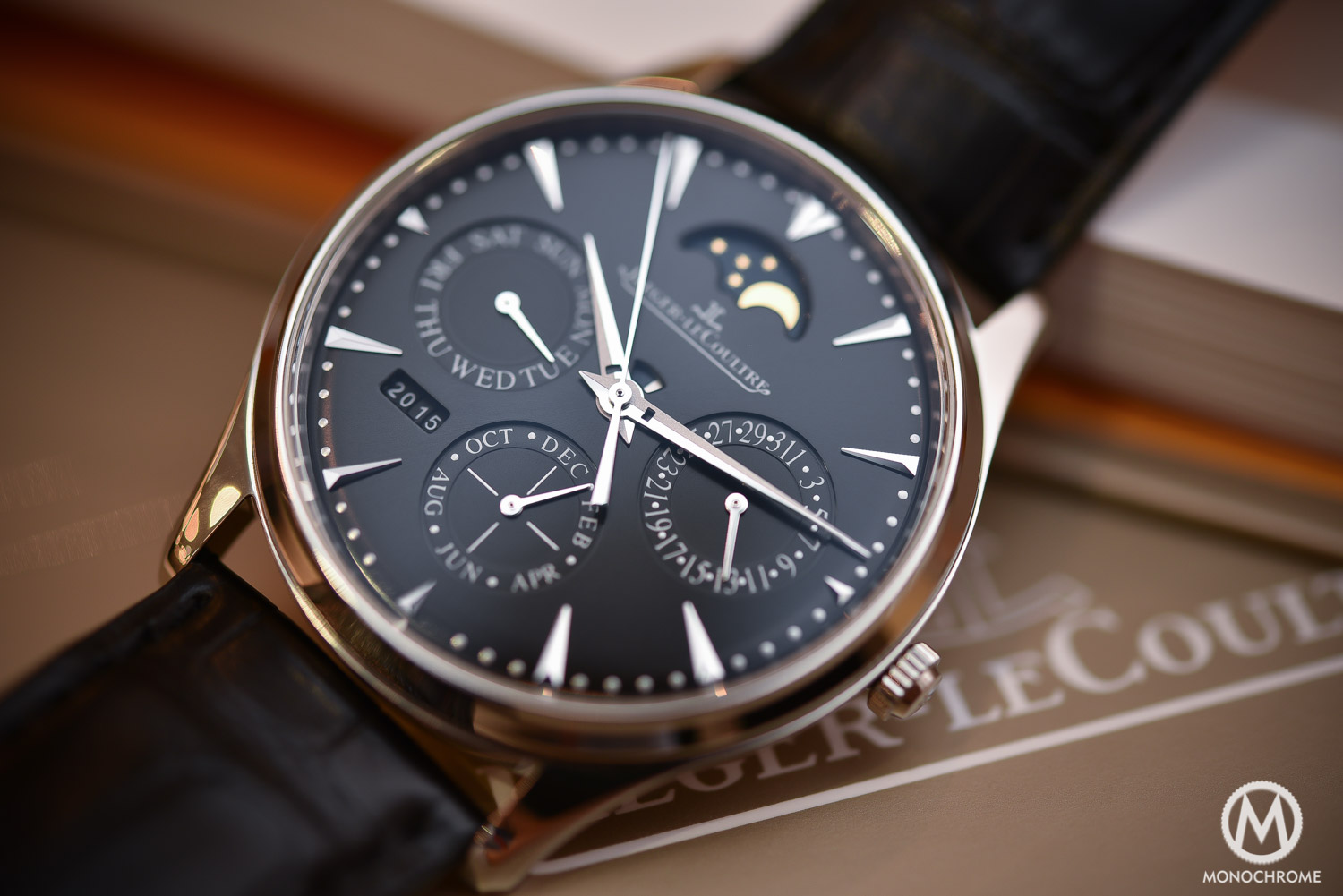



11 responses
How do you go about changing all the indications?
Hi Michael, the indications have not really changed. Only the module atop the movement has been rotated 180 degrees. Personally I love it, and it looks very balanced
Doesnt he mean how to re-set the date etc in case the watch has stopped for more than a day ? I think there is a pusher in the side of the case somewhere ? or can you adjust the day with setting of the crown like in the IWC Perpetuals ?
It is a great watch and while 37mm was defintely to small, maybe this is the right size.
Not even one photo that shows the side view of the (ultra thin) watch?
Can the author of this article please confirm that the statement “The rose gold rotor features the brand’s logo (JL) that now-a-days also features in the brand’s Gyrolab balance!” together with the 2 pictures showing that back of the watch are indeed for this new Master 8 days Perpetual black dial watch by JLC?
The non-black dial versions do not seem to have this rose gold “JL” rotor at all.
Many thanks.
@HC The watch in question isn’t the Master 8-Days, but the new Master Ultra-Thin Perpetual, and all photos are of that watch!
Steel case with silver coloured indices and hands on a black dial; what gives with the gold moon on a blue disk (and the white/blue warning disk for that matter)?
So close to being a beautiful watch, ruined by these injections of inappropriate colours. The watch is black and silver, space is black and the moon is often described as silver. So who thought blue and gold was a good idea? And why not black/white or black/red for the warning disk? Crazy decisions.
The moon indicator is not “simple” revolving at 29.5 days with a 44 min drift. I have confirmed with the JLC engineers. It is a much more sophisticated 29.53125 (meaning a gear with 130+ teeth). This watch won’t drift meaningfully until it needs to be adjusted in 140 years for the date. I suspect many buyers won’t be inconvenienced by this.
Thanks Dave. You just confirmed that the moon indicator is running on 135-tooth-gear. I am going to get one soon 🙂
Regarding the moon phase accuracy the main article should be corrected. This is definitely NOT a “simple moonphase”. Quote from the operating manual: “The date, day of the week, month, year, and moon phase are therefore indicated mechanically, without the slightest need for readjustment until 1 March 2100.” Regarding the moon phase, the manual is very clear.
Hi Harald, mechanical watches with a moonphase that is precise for approx. 122 years are considered a simple moonphase. Some moon phase indications are precise for the coming 11,000 years or more. Here’s a link to our Technical Perspective on Moon Phase watches -> https://monochrome-watches.com/technical-perspective-moon-phase-watches/